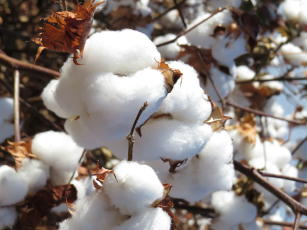Amazon fungus improves soybean growth and development
Amazon fungus improves soybean growth and development
Photo: Antônio Carlos Pereira Góes

The Amazon forest also harbors a vast microbiological diversity. It is a valuable source for the bioprospection of fungi and the products they generate
|
A fungus that occurs in the Amazon Forest soil proved to be an important stimulant for plant development. Researchers from Embrapa Environment assessed over 1,000 lineages of the Trichoderma fungus combined with two sources of phosphorus, and found that many of them promote the growth of soybean plants. The results were published on the magazine Scientific Reports , from the Nature group.
The microorganism solubilizes the phosphorus present in the soil, allowing the mineral to be easily be absorbed by the plant. As a consequence, soybeans grow faster and farmers can save in the application of the nutrient. In addition to savings for farmers, the use of the technology reduces the risk of phosphorus sediment being transported into water bodies, providing sustainability to the production. The discovery can originate a biofertilizer, in the shape of an inoculant, for important cash crops. Trichoderma bioinoculants are formulated based on fungal parts, generally spores. They are applied either through seed treatment or directly onto the soil. They are used in different crops of economic importance to benefit germination and initial plant growth stages.
The increasing use of mineral fertilizers has contributed to reduced soil health as it causes contamination. Thus, the biofertilizantes to the base of beneficial microrganismos can annul these problems, and also reduce the production costs.
The Trichoderma fungus-based product can be applied in different crops, from vegetables to major crops like soybeans, maize and beans. In addition, it has the extraordinary potential to colonize the root system and the rhizosphere, a basic requirement so that the microorganism settles and promotes plant growth, increasing phosphorus supplies.
For future products, the choice of the technology for fungus applications will depend on the development of formulas. "In this case, we do have a standardized formula yet", explains the Embrapa researcher Itamar Melo.
“We do have an efficient method to produce spores. The fungus lineages studied here sporulate very quickly, between three and six days in natural culture media, an additional advantage in comparison with the products available in the market nowadays. Innovative action regarding the development of an efficient biofertilizer would potencialize the association of lineages of the same fungus species with specific functions to promore plant growth, improve their structuring and soil health, and control pathogens that inhabit the soil.
The research
Soybean plants that were inoculated with selected Trichoderma lineages were cultivated in the soil with rock phosphate and triple superphosphate. The researchers observed a 40% increase in the biomass of the plants that were inoculated with the microorganism. And in those plants the efficiency in phosphorus absorption was up to 141% higher than in the group that did not rely on Trichoderma sp.
The biologist Laura Bononi, who used the research in her PhD for the University of São Paulo's Luiz de Queiroz College of Agriculture (Esalq/USP), reveals that the fungus was capable of producing different organic acids during the process. “Such acids are important to release the phosphorus contained in iron and aluminum oxides, that is, to convert the phosphate present in the environment into monobasic or dibasic phosphates, which are readily available for absorption”, reports the biologist, who was advised by Melo.
Phosphorus plays vital roles in all stages of plant development and its deficiency can reduce the growth and the productivity of many crops. Acid soils, which are rather common in Brazil, promptly retain this mineral as it is applied as a fertilizer and do not make it available for the plants. “The use of microorganisms that solubilize phosphate is a sustainable and promising strategy to manage this deficiency in agricultural soils”, states Melo, stressing that this technology allows takes advantage of different types of rock phosphates from Brazilian mines. Currently, these phosphates are not commonly used as fertilizers, which makes Brazil import them.
The importance of phosphorus
The scientist explains that nitrogen and phosphorus are the nutrients that most limit agricultural production and are essential in early plant development. However, Brazilian soils naturally have low amounts of the element, which entails the application of large quantities of phosphate. Phosphorus is associated with three basic biochemical processes: energy production, respiration and photosynthesis. It also participates in enzymatic processes and composes structures in the plant cells like nucleic acids and cell membranes.
Despite there being a large amount of phosphorus in the soil, its low availability for plants is one of the main obstacles to agricultural productivity. Crops are only able to absorb between 10% and 40% of the total of the mineral that is applied to the soil. This phenomenon is due to a high degree of reactivity between phosphorus and soil constituents, which causes the mineral to fixate or precipitate with soil particles, making it unavailable for plant absorption. Maize, soybeans and sugarcane are the crops that receive most of the phosphatic fertilizers used in Brazil.
Amazon, cradle of species
On top of its vast plant and animal biodiversity, the Amazon Rainforest also harbors a vast microbiological diversity. Fungi, in special, participate in the constant process of degradating the biomass generated in the biome, which makes the Amazon region a valuable source for the bioprospection of such microorganisms and the products they generate.
The use of microorganisms as biofertilizers is a promising approach to aid agricultural production. Such applications have contributed to the growth of several crop species, increased plant biomass and total phosphorus content, and participated in phosphorus cycling without affecting the environment. Last year, Brazil launched its first inoculant to solubilize phosphorus. The fruit of a partnership between Embrapa and the company Bioma, BiomaPhos results from the action of two bacteria and targets maize crops.
Agricultural and pasture soils are composed by larger communities of these microrganisms involved in the availability of phosphorus. They are essential to supply plants with the soil nutrient through the processes of mineralization and solubilization. The fungi have an advantage over the bacteria because they can keep an aggregate in the soil provided by the growth of their hyphae (filaments). This way, it can help the plant acquire nutrients and water, and protects it from the attack of plant pathogens.
Translation: Mariana Medeiros Cristina Tordin (MTb 28.499/SP)
Embrapa Environment
Press inquiries
meio-ambiente.imprensa@embrapa.br
Lebna Landgraf (MTb 2903/PR)
Embrapa Soybeans
Press inquiries
soja.imprensa@embrapa.br
Further information on the topic
Citizen Attention Service (SAC)
www.embrapa.br/contact-us/sac/


